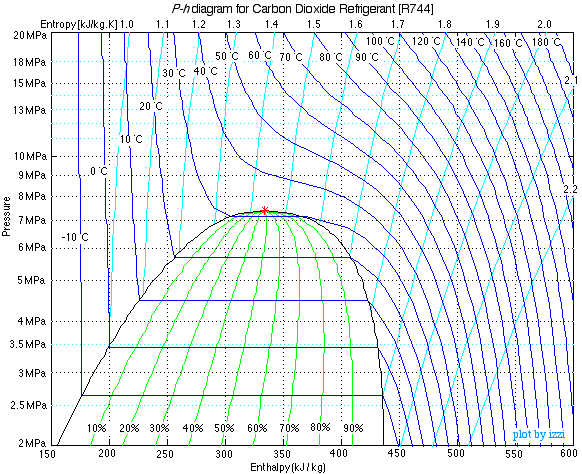Problem 4.17 - A R744 (CO2) Home Geothermal Heat-Pump
Introduction and Description
With the global quest for energy efficiency, there is renewed interest in geothermal heat pumps which have been in limited use for more than 70 years. Essentially this technology relies on the fact that a few meters below the surface of the earth the temperature remains relatively constant throughout the year, warmer than the air above it during winter, and cooler during summer. According to the Spring 2009 newsletter from David White, in Southeast Ohio this temperature is around 55°F (13°C). This means that we can design a heat pump which can combine hot water and space heating in winter in which the earth is used as a heat source (rather than the outside air) at a considerable increase in coefficient of performance COP. Similarly, with suitable valving, we can use the same system in summer for hot water heating and air conditioning in which the earth is used as a heat sink, rather than the outside air. This is achieved by using a Ground Loop in order to enable heat transfer with the earth, as described in the Popular Mechanics website: The Guide to Home Geothermal Energy, and of course the ubiquitous Wikipedia. Another relevant website is that by Mortgage Calculator titled Geothermal Resources for Homeowners (Thanks to Aaron March of Jericho, VT, for making us aware of this interesting website - Nov 21, 2011.)
![]() Problem
4.17 - We wish to do a preliminary
thermodynamic analysis of the following CO2 home geothermal heat pump
system designed for wintertime hot water and space heating. Notice
that with suitable valving this system can be used both in winter
for space heating and in summer
for air conditioning, with hot water heating throughout
the year.
Problem
4.17 - We wish to do a preliminary
thermodynamic analysis of the following CO2 home geothermal heat pump
system designed for wintertime hot water and space heating. Notice
that with suitable valving this system can be used both in winter
for space heating and in summer
for air conditioning, with hot water heating throughout
the year.
Notice that the gas cooler section includes both the hot water and space heater. We assume that 50°C is a reasonable maximum hot water temperature for home usage.
Using the conditions shown on the diagram:
a) On the P-h
diagram provided below carefully plot the seven
processes of the heat pump and highlight relevant portions of the
following constant temperature lines: 50°C (hot water), 13°C
(ground loop), and -10°C (outside air temperature).
b) Using the R744
property tables determine the enthalpies at all seven stations and
verify and indicate their values on the P-h
diagram.
c) Determine the mass
flow rate of the refrigerant R744. [0.0167
kg/s (1 kg/min)]
d)
Determine the power absorbed by the hot water heater
[2.42 kW] and
that absorbed by the space heater. [1.5
kW]
e) Determine the time
taken for 100 liters of water at an initial temperature of 20°C to
reach the required hot water temperature of 50°C. [1
hr 26 minutes]
f) Determine the
Coefficient of Performance of the hot water heater (COPHW)
[2.42] and
that of the space heater (COPheat)
[1.5]
(recall that COP is defined as the heat absorbed
divided by the work done on the compressor).
g) What changes would
be required of the system parameters if no geothermal water loop was
used, and the evaporator was required to absorb its heat from the
outside air at -10°C? Discuss the advantages of using the
geothermal ground loop heat pump system.
